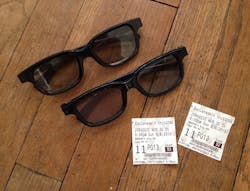
In last year's 2014 Laser Marketplace Review, a discussion of laser cinema revealed that in 2010, 33% of the total dollars earned by 127 film releases were earned by just four 3D movies. I used to think that 3D movies were just a passing fad and this epic earning season in 2010 was just an outlier, but my views have changed after seeing Jurassic World a few weeks ago in IMAX 3D: I'm a believer! A believer in the successful future of 3D movies, that is.
Prior to Jurassic World, the only 3D movie I had seen was a short thriller in a small theatre at Sea World called R. L. Stine's Haunted Lighthouse. The visual effects in that movie were interesting, but paled in comparison to having Indominous Rex hurl his big teeth into your face or the Mosasaurus snap up a huge shark like a sardine in Jurassic World; I actually spilled some of my popcorn when the waiter came by to ask if I needed something during a particularly interesting fight scene between dinosaurs--I was truly "jumpy" at the onscreen action--talk about virtual reality immersion--and the waiter startled me a bit. When the movie ended, I proclaimed to my husband that Jurassic World was the best of the Jurassic series that I had ever seen (see image below from Daily Capital showing the Mosasaurus feeding on a shark).
While the movie did require us to wear glasses, was a bit dim, and did--I must admit--make me feel a bit disoriented during the first five minutes or so (could have been because we were sitting in the front row), I can't imagine watching it again in flat 2D format. The official world trailer is embedded here, albeit not viewable in 3D from your desktop.
I'm a believer, and I want to see laser projectors play a bigger role in the success of 3D movies. Turns out I'm not alone; according to information cited at http://www.worldtvpc.com/blog/3d-movie-revenues-reach-all-time-low-in-u-s/, while major box office revenues in the United States represented only around 30% of the screenings for those 3D movies shown recently, 3D films are responsible for “80% to 90% of a film's box office take in places like Russia and China."
About the Author

Gail Overton
Senior Editor (2004-2020)
Gail has more than 30 years of engineering, marketing, product management, and editorial experience in the photonics and optical communications industry. Before joining the staff at Laser Focus World in 2004, she held many product management and product marketing roles in the fiber-optics industry, most notably at Hughes (El Segundo, CA), GTE Labs (Waltham, MA), Corning (Corning, NY), Photon Kinetics (Beaverton, OR), and Newport Corporation (Irvine, CA). During her marketing career, Gail published articles in WDM Solutions and Sensors magazine and traveled internationally to conduct product and sales training. Gail received her BS degree in physics, with an emphasis in optics, from San Diego State University in San Diego, CA in May 1986.

